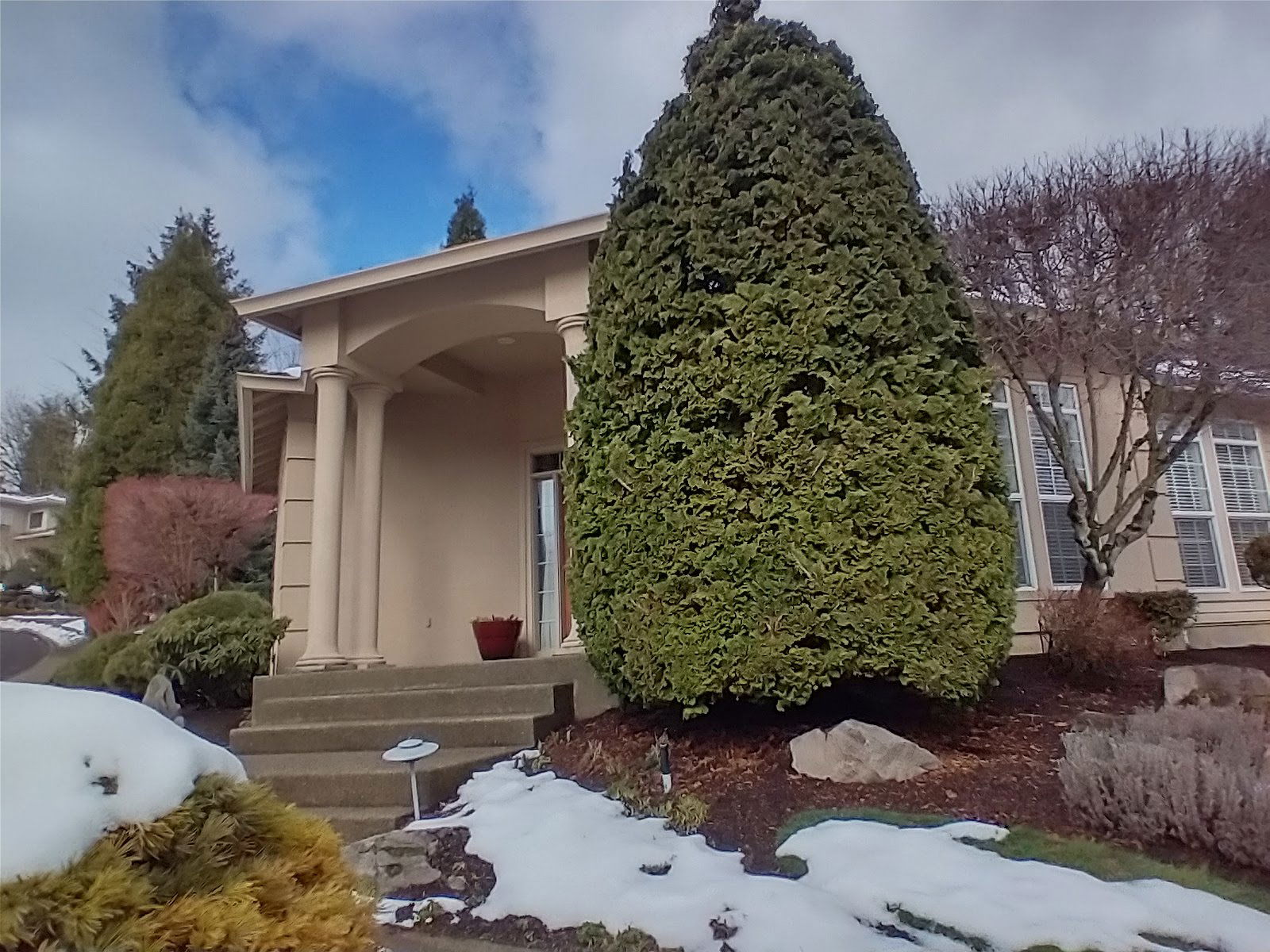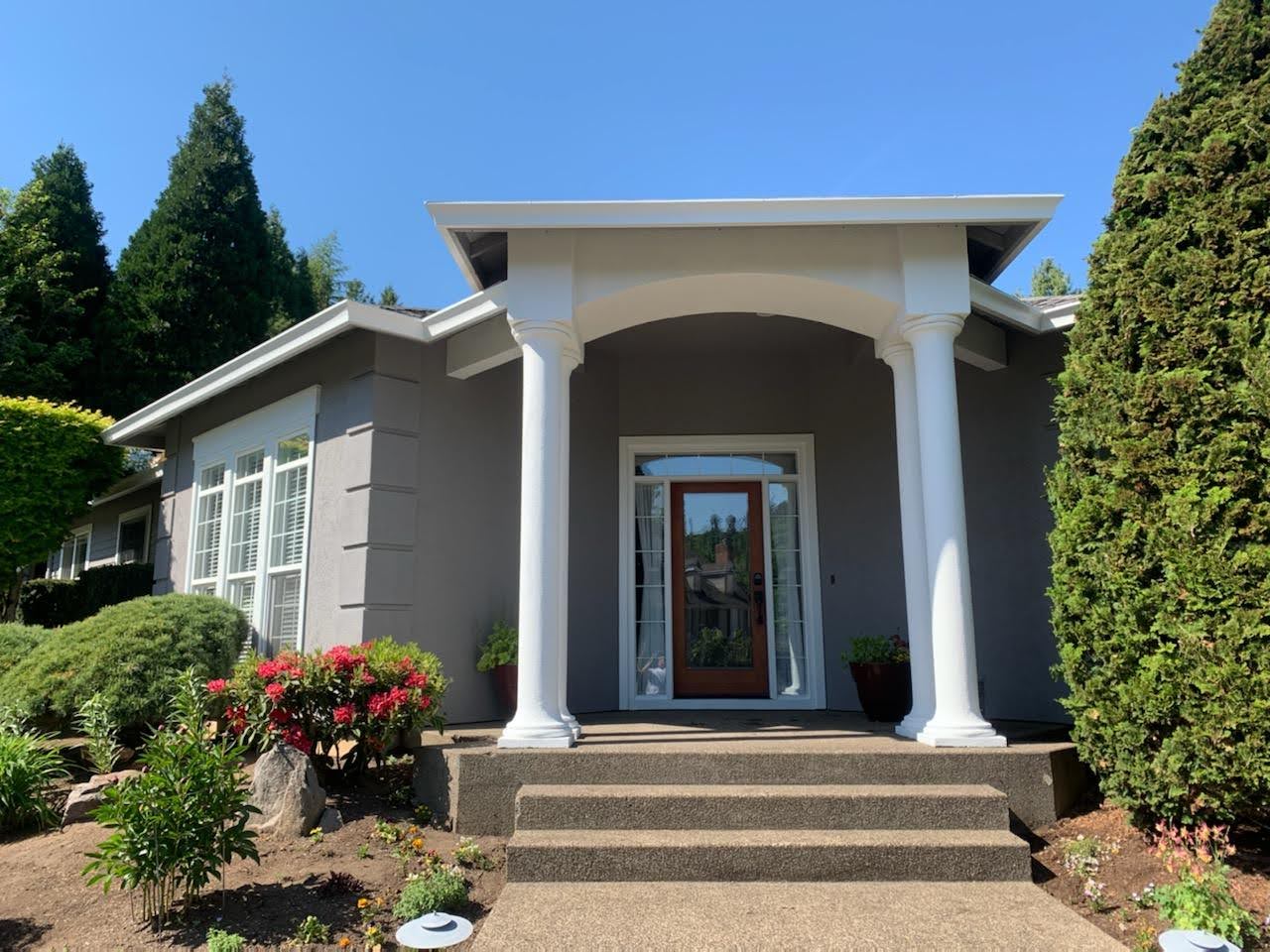Can I Paint Stucco? Pros vs. Cons for Homeowners

Key Highlights of the Article
- Enhanced Aesthetic Appeal: Painting stucco can dramatically improve curb appeal with a wide range of color options.
- Added Protection: Paint provides extra protection against moisture and UV rays but requires careful selection of breathable products.
- Potential Drawbacks: Painting stucco can trap moisture, leading to peeling, cracking, and increased maintenance costs.
- Alternatives to Painting: Consider alternatives like staining or recoloring stucco, which may provide a fresher look without the risks associated with paint.
Can I Paint Stucco? Pros vs. Cons for Homeowners
Stucco has long been a popular choice for exterior finishes, particularly in regions with dry, warm climates. Its durability, aesthetic appeal, and energy efficiency make it a go-to for many homeowners. But when it comes to changing the look of your stucco, the question often arises: Can you paint stucco? While the answer is yes, it’s essential to weigh the pros and cons before picking up that paintbrush. In this guide, I’ll walk you through the key considerations to help you decide whether painting your stucco exterior is the right move.
Understanding Stucco as a Material
What is Stucco?
Stucco is a versatile and durable material composed primarily of cement, sand, and lime. This mixture is applied in layers to create a hard, textured surface that can withstand various environmental factors. One of the reasons stucco is so popular, especially in regions like the Southwest, is its ability to resist heat and provide insulation, keeping homes cooler in hot climates. Additionally, stucco’s natural composition allows it to “breathe,” helping to prevent moisture buildup within the walls, which is crucial for maintaining structural integrity.
Another characteristic that sets stucco apart is its natural, textured appearance. This finish gives homes a unique, timeless look that can vary from smooth to rough, depending on how the stucco is applied. Many homeowners appreciate this natural aesthetic because it blends seamlessly with the surrounding environment and offers a distinct architectural charm.
Why Homeowners Consider Painting Stucco
Aesthetic Reasons
One of the most common reasons homeowners consider painting stucco is to update the appearance of their home. Over time, even the most well-maintained stucco can develop stains, discoloration, or a faded look due to exposure to the elements. Painting provides an opportunity to refresh the home’s exterior, cover up imperfections, and align with a new color scheme or design preference.
I’ve seen this firsthand in several projects where a fresh coat of paint on stucco made the entire property look more modern and well-kept. It’s also an excellent option if you’re looking to boost curb appeal before selling your home. However, it’s worth noting that stucco’s natural texture will still show through the paint, preserving that distinctive look while offering a renewed surface.
Maintenance and Protection
Beyond aesthetics, painting stucco can add an extra layer of protection to your home. While stucco is inherently durable, it can still be vulnerable to environmental factors such as UV rays, rain, and wind. A quality exterior paint acts as a shield, helping to protect the stucco from these elements and extending its lifespan.
Moreover, paint can seal small cracks and prevent moisture from penetrating the surface, which is particularly beneficial in climates with fluctuating weather patterns. This added protection can help reduce the need for frequent repairs and maintenance, saving homeowners time and money in the long run.
However, it’s essential to choose the right type of paint—specifically one that is breathable. A non-breathable paint can trap moisture within the stucco, leading to potential issues like mold or mildew. That’s why I always recommend consulting with a professional to select a paint that complements the unique properties of stucco.
Things to Know
- Proper Paint Selection: Ensure the paint is breathable to prevent moisture issues.
- Preparation is Crucial: Adequate cleaning and repairing of the stucco surface before painting are vital to prevent future problems.
- Professional Application Recommended: Due to the complexities involved, professional application is recommended to achieve the best and most durable results.
- Regular Maintenance Required: Even with the best paint job, regular maintenance is necessary to keep the stucco in top condition.
- Consider the Climate: Local climate should heavily influence the decision to paint stucco, as certain environmental conditions can accelerate wear and tear.
Pros of Painting Stucco
Painting stucco can be an excellent choice for homeowners looking to enhance their home's exterior. From a wide range of color options to additional protection against the elements, painting stucco offers several benefits that can transform your property. Let's dive into the pros to help you determine if this is the right move for your home.
Enhanced Aesthetic Appeal
Color Variety
One of the most significant advantages of painting stucco is the freedom to choose from a wide range of colors. Unlike natural stucco, which is often limited to earth tones or neutral shades, painting opens up endless possibilities for customization. Whether you want a classic white finish or a bold, modern color, paint allows you to tailor your home’s exterior to reflect your personal style.
I've seen firsthand how a new color can completely transform a home's appearance. One client opted for a deep charcoal gray on their stucco exterior, instantly giving their property a sleek, contemporary look that set it apart in their neighborhood. With the right color, you can make a statement, improve curb appeal, and even enhance your home’s market value.
Modernizing Older Homes
For older homes, painting stucco is a simple yet effective way to modernize the exterior. Stucco finishes can sometimes appear dated, especially if they’ve been exposed to the elements for years. A fresh coat of paint can breathe new life into your home, making it look newer and more in line with current design trends.
Older stucco can develop cracks and discoloration over time, which paint can easily conceal. Plus, you can update the style of your home without the need for expensive renovations. It’s a cost-effective way to keep your property looking fresh and inviting, especially if you're considering putting it on the market soon.
Additional Protection
Weather Resistance
Another great reason to consider painting your stucco is the additional protection it provides against harsh weather conditions. Stucco is naturally porous, which means it can absorb moisture—a real concern in wet or humid climates. Applying a high-quality exterior paint can create a barrier that prevents water penetration, helping to protect the underlying structure from damage like mold, mildew, and rot.
Living in the Pacific Northwest, I’ve seen how crucial this layer of protection can be. The rain here can be relentless, but a well-chosen paint with waterproofing qualities can extend the life of stucco, keeping it looking great and structurally sound for years to come.
UV Protection
Stucco is also vulnerable to UV rays, which can cause the surface to fade and deteriorate over time. A high-quality exterior paint provides a shield against UV damage, preserving the vibrancy of your chosen color and preventing chalking and other signs of aging. It’s not just about looks, though—UV protection also helps maintain the stucco’s integrity, reducing the likelihood of cracks and other forms of deterioration.
Easy Maintenance
Simplified Cleaning
Maintaining painted stucco is often easier than caring for unpainted surfaces. Painted stucco is generally easier to clean, as dirt, dust, and debris do not adhere as strongly to the smooth paint surface. A simple wash with a garden hose or pressure washer is often all that’s needed to restore the exterior to its freshly painted glory.
I've worked with clients who found that after painting their stucco, they needed to clean it far less frequently. This is particularly beneficial in urban areas or regions prone to wind and dust, where homes can get dirty quickly. With painted stucco, a little water and mild detergent can usually do the trick, saving you time and effort.
Resists Stains and Mold
Paint can also serve as a barrier against common stucco issues like stains, mold, and mildew. Stucco’s porous surface can easily absorb contaminants, leading to unsightly stains or even mold growth. However, a good exterior paint can seal these pores, reducing the likelihood of such problems. This is especially valuable in areas with high humidity or frequent rain, where mold and mildew are more prevalent.
By choosing a paint designed to resist mildew and stains, you not only keep your home looking pristine but also protect the health of your household. Plus, who wants to spend weekends scrubbing mold or trying to remove stubborn stains? Painted stucco can make these tasks a thing of the past.


Cons of Painting Stucco
While painting stucco can offer several benefits, it’s important to weigh these against the potential drawbacks. Knowing the cons can help you make an informed decision about whether painting your stucco is the best choice for your home.
Potential for Trapping Moisture
Moisture Issues
One of the most significant concerns when it comes to painting stucco is the potential for trapping moisture. Stucco is a porous material, designed to "breathe" and allow moisture to escape from the surface. However, if the paint applied is not breathable, it can trap moisture beneath the surface, leading to a host of problems.
Imagine moisture getting trapped behind a layer of non-breathable paint—it’s like putting a lid on a boiling pot of water. This can result in peeling, cracking, and even damage to the underlying structure. Over time, trapped moisture can compromise the integrity of the stucco and the home’s walls, leading to costly repairs.
Breathability Concerns
To mitigate these moisture issues, it’s crucial to use a breathable paint specifically designed for stucco. This type of paint allows moisture to escape while still providing a protective coating. However, not all paints on the market offer this breathability, and choosing the wrong product can do more harm than good. I’ve seen instances where homeowners were unaware of this and ended up with peeling paint just a year after application. Ensuring your paint choice supports the natural breathability of stucco is essential.
Maintenance and Repainting
Regular Upkeep
Unlike natural stucco, which requires relatively low maintenance, painted stucco demands more frequent upkeep. To maintain its appearance and protective qualities, painted stucco typically needs to be repainted every 5-10 years, depending on factors like climate, quality of paint, and exposure to sunlight. This regular maintenance can become a burden for some homeowners, particularly those looking for a long-term, low-maintenance solution.
Peeling and Cracking
Over time, painted stucco may begin to peel or crack, especially in regions with extreme weather conditions. This peeling or cracking often requires additional touch-ups or even a complete repaint, which can be both time-consuming and expensive. For example, if you live in an area with intense heat, cold, or frequent moisture exposure, you may find that the painted stucco needs more attention than you initially expected.
Cost Considerations
Initial Cost
Painting stucco is not a minor expense. It can be a significant investment, particularly if you choose to hire professional painters to ensure the job is done correctly. The cost of paint, labor, and preparation can add up quickly. Depending on the size of your home and the complexity of the project, the initial cost can be substantial.
Long-Term Costs
Beyond the initial expense, there are long-term costs to consider. The need for regular maintenance, touch-ups, and eventual repainting adds to the overall cost of painting stucco. If you're budgeting for a painting project, it’s essential to account not only for the initial outlay but also for the recurring costs that will come up over the years.
Alternatives to Painting Stucco
For those who are hesitant about painting stucco due to these potential downsides, there are other options available that can still enhance your home’s appearance without the same risks.
Restaining or Recoloring
Stucco Stain
One alternative to painting is staining stucco. Unlike paint, stains penetrate the surface, providing a new color without creating a barrier that could trap moisture. Stucco stains are designed to refresh the color while preserving the material’s natural breathability. This option allows you to update your home's appearance without the risk of peeling or cracking often associated with painted stucco.
Recoloring Options
Another alternative is recoloring the stucco with a new layer of finish coat. This process involves applying a new finish that enhances the color without using paint. It’s similar to staining but allows for a broader range of color options and finishes. Recoloring offers a compromise by providing a refreshed look while maintaining the stucco’s natural properties.
Natural Stucco Maintenance
Stucco Patching
If your stucco has minor cracks or blemishes, patching and touch-ups can maintain the natural look without resorting to paint. There are various patching products available specifically designed for stucco that blend seamlessly with the existing texture. Addressing these issues early can help prevent further damage and maintain the integrity and appearance of your stucco.
Sealants and Waterproofing
Another effective alternative is applying clear sealants to protect the stucco from moisture without altering its appearance. Sealants offer a layer of protection against the elements while preserving the natural color and texture of the stucco. This can be a great solution for homeowners who appreciate the look of stucco but want to add some additional protection against water damage.
In Our Experience:
"We've found that while painting stucco can dramatically enhance a home's appearance and protection, the key to success lies in meticulous preparation and choosing the right materials. Correctly executed, a stucco paint job not only beautifies the facade but also fortifies the structure against weather and wear."
Best Practices for Painting Stucco
Painting stucco can be a fantastic way to refresh the exterior of your home, adding color, protection, and curb appeal. However, painting stucco isn't as straightforward as slapping on a coat of paint. It requires careful preparation and the right materials to ensure a durable and aesthetically pleasing finish. Let’s dive into the best practices for painting stucco to help you achieve a professional-grade result that lasts.
Proper Surface Preparation
Cleaning and Repairing
Before painting stucco, thorough surface preparation is absolutely essential. Stucco is known for its textured, porous surface, which can collect dirt, mold, and mildew over time. Any dust, grime, or contaminants left on the surface can interfere with paint adhesion, leading to peeling or bubbling down the line. I can’t stress enough how critical it is to start with a clean slate. Use a pressure washer or a mild detergent and water solution to thoroughly clean the stucco surface. Allow it to dry completely before moving on to the next step.
Additionally, inspect the stucco for any cracks, chips, or damage. These imperfections should be repaired before painting. Fill small cracks with a quality stucco patching compound, and for more extensive damage, consider hiring a professional to handle the repairs. Remember, painting over damaged stucco is like putting a bandage over a wound—it may cover the issue temporarily, but it won't resolve the underlying problem.
Choosing the Right Primer
Once the stucco is clean and repaired, the next crucial step is choosing the right primer. Not all primers are created equal, especially when it comes to stucco. It’s important to use a high-quality, breathable primer specifically designed for stucco surfaces. This type of primer allows moisture to escape from the walls, preventing buildup that could cause peeling or bubbling.
I’ve seen instances where skipping or using the wrong primer led to costly mistakes and repeat work. A good primer not only enhances paint adhesion but also helps the paint last longer, protecting your home’s exterior from the elements. Don’t cut corners here—investing in a proper primer can save you time, money, and headaches down the road.
Selecting the Right Paint
Breathable Paint Options
When it comes to painting stucco, selecting the right paint is just as important as preparing the surface. The best choice is a breathable paint that allows stucco to continue to breathe while adding a layer of protection. This is vital for preventing moisture buildup, which can lead to serious issues like mold, mildew, and structural damage. Breathable paints are specifically designed for masonry surfaces and provide a durable finish that can withstand various weather conditions.
Quality Over Cost
While it might be tempting to go for a cheaper option, quality matters more than cost when painting stucco. Investing in a high-quality exterior paint can provide better coverage, longer-lasting color, and superior protection against UV rays and weather damage. Cheaper paints may fade, peel, or crack much faster, requiring you to repaint more frequently, which ends up being more expensive in the long run.
Consider paint brands that are known for their durability and weather resistance, especially those recommended for stucco surfaces. A little extra investment upfront can save you from frequent maintenance and touch-ups, ultimately providing better value over time.
Hiring a Professional vs. DIY
When to Hire a Pro
Painting stucco can be a challenging task, particularly for large or complicated surfaces. If your home has multiple stories, intricate architectural details, or significant damage, it might be wise to hire a professional. Professionals have the experience, tools, and knowledge needed to ensure a flawless finish, saving you time and stress. They also understand how to choose the right paint and primer for your specific climate and stucco type.
DIY Tips
For those who are comfortable with DIY projects, painting stucco yourself can be a rewarding task—provided you follow best practices. Use the right tools like high-quality brushes, rollers, and sprayers specifically designed for stucco. Maintain a consistent application technique to avoid streaks or uneven coverage. Also, ensure you have adequate ladders or scaffolding for safe access to all areas of your home.
Remember to apply multiple thin coats of paint rather than one thick coat. This approach helps the paint adhere better and reduces the risk of drips or uneven patches. Lastly, check the weather forecast—painting in extreme heat, cold, or rain can affect the paint's drying process and lead to a less-than-perfect finish.
Is Painting Stucco Right for Your Home?
Recap
Painting stucco offers several benefits, from enhanced aesthetics to additional protection against weather elements. However, it also comes with challenges, such as the potential for trapped moisture and the need for regular maintenance. By following best practices—like thorough preparation, using the right materials, and knowing when to hire a professional—you can achieve a beautiful, long-lasting finish.
Ultimately, the decision to paint stucco should be based on your specific needs and circumstances. Consider factors like your home’s age, local climate, and your willingness to maintain the painted surface over time. By carefully weighing these considerations, you can make the best choice for your home and enjoy a stunning exterior for years to come. If you’re unsure, consulting with a professional painter can provide you with tailored advice to help you achieve the best results.
Do You Have Questions? Give Us A Call With Any & All! 503-389-5758
-
People Also Ask:
Can you paint over stucco?
Yes, you can paint over stucco, but it's essential to consider the pros and cons before doing so. Painting stucco can enhance aesthetic appeal and provide additional protection, but it must be done correctly to avoid trapping moisture and causing damage.
What are the risks of painting stucco?
The primary risks include trapping moisture beneath the paint, which can lead to peeling, cracking, and even structural damage if moisture penetrates deep enough. It's crucial to use breathable paint and ensure proper surface preparation to mitigate these risks.
Is it better to paint or stain stucco?
The choice between painting and staining stucco depends on several factors, including the desired aesthetic and maintenance requirements. Staining can refresh the color without sealing off the surface, allowing for better moisture evaporation, while painting provides a thicker protective layer but requires careful application to maintain breathability.
-
SUBSCRIBE TO OUR BLOG: Stay informed with the latest in Painting and DIY projects by subscribing to Lightmen Painting. Get insights, tips, and more delivered straight to your inbox. We would also love to know what you would like to read about, leave thoughts on where we should go next. Interests, Topics, Ideas, all are welcome.
If your in the Portland, Or. area and need advice or a free no obligation estimate call us at 503-389-5758 or email scheduling@lightmenpainting.com
Shout Out:
Celebrating Paint with Pinnacle: Experts in Painting Services and Advice
From the team at Lightmen Painting, we extend our highest praise to Paint with Pinnacle for their dedication to providing exceptional painting services and expert advice. Their blog offers valuable insights on everything from exterior paint finishes to choosing the right services for your business. Just as we strive for excellence and meticulous craftsmanship, Paint with Pinnacle helps homeowners and businesses make informed decisions for their painting projects, aligning perfectly with our mission to enhance and beautify environments.
Thanks for stopping by Lightmen Daily! Stay tuned for more practical tips and expert advice on making your painting projects flawless, from wall to floor!
Definitions
- Stucco: A durable, porous wall covering made from cement, lime, and silica applied in several layers over wood or metal lath.
- Breathability: The ability of a material, like paint, to allow air and moisture to pass through it, which is crucial in preventing moisture buildup in stucco.
- Moisture Trapping: When paint applied over stucco seals off the surface too tightly, preventing moisture from escaping, which can lead to damage.
- UV Protection: Paints that include ingredients to block or reflect ultraviolet light, helping to prevent the degradation and discoloration of the underlying material.
- Aesthetic Appeal: The visual attractiveness of a building's exterior, which can be significantly enhanced by the choice of paint color and quality.
- Durability: The ability of painted stucco to withstand environmental factors like sun, rain, and wind without deteriorating.
- Maintenance: The ongoing care required to keep painted surfaces in good condition, including cleaning and occasional repainting.
- Residential Painting: Specific painting services tailored to private residences, focusing on aesthetic and protective properties suitable for home environments.
- Commercial Painting: Painting services provided for businesses and commercial properties, often involving larger scale and durability requirements.
- Paint Quality: Refers to the grade of paint used, which affects coverage, durability, color retention, and overall performance on stucco surfaces.
Lightmen Painting Serving: Portland, Tigard, Lake Oswego, Tualatin, West Linn, Milwaukie, Sherwood, Happy Valley, Oregon City, Beaverton, Hillsboro, Gresham -Trade Partners-

